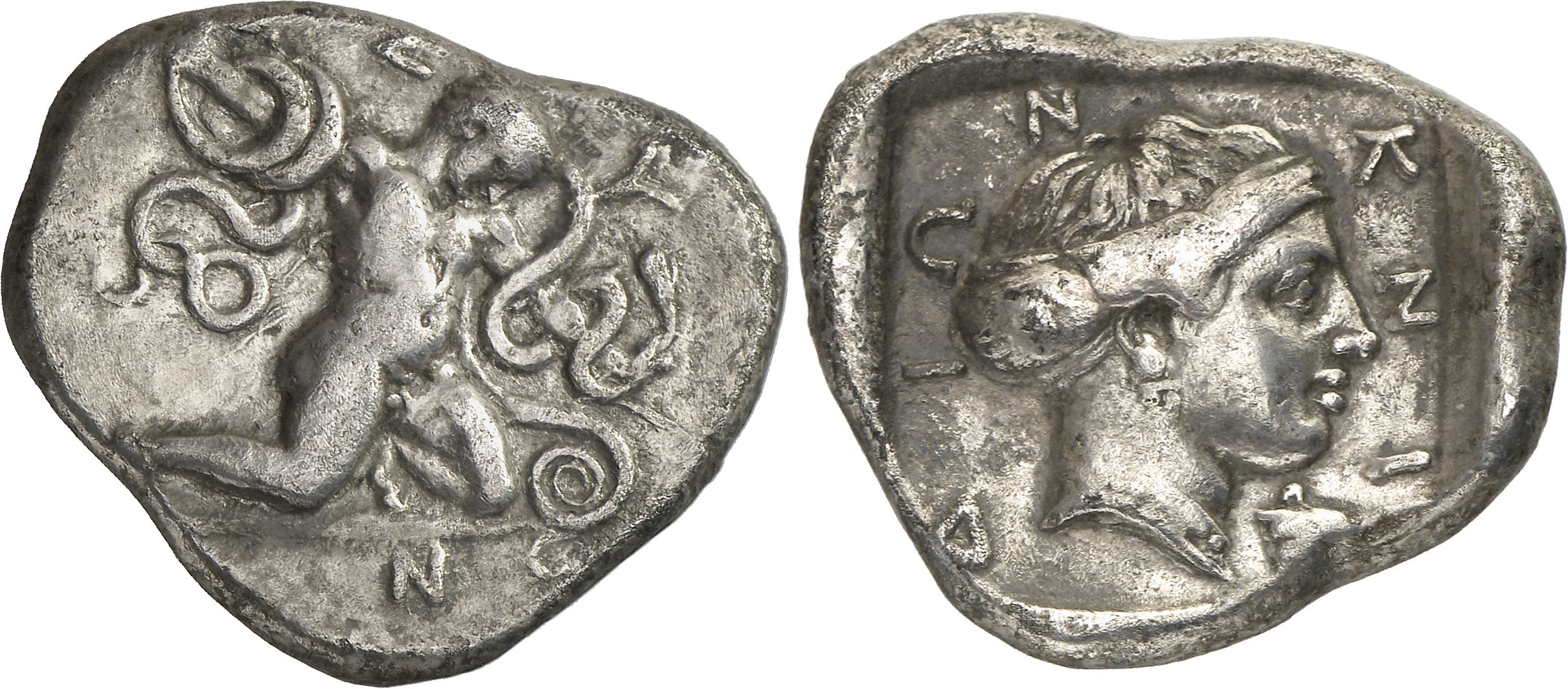Cnidus, silver, double sigloi ΣYN (405 BCE) Delrieux
From SILVER
405 BCE - 405 BCE Silver 1,024 kg
Description
| ObverseInscription or printing placed on the obverse.: | Σ-Y-N (Greek).The infant Herakles, naked, kneeling to right on ground line, strangling a serpent in each hand |
| ReverseInscription or printing placed on the reverse.: | KNI-Δ-IΩ-N (Greek).Head of Aphrodite facing to right, her hair rolled, a prow before, all within an incuse square |
Mint and issuing power
| MintIdentifies the place of manufacture or issue of a numismatic object.: | Cnidus | Ancient regionAncient region.: | Caria | Modern countryModern country: Turkey | AuthorityIdentifies the issuing power. The authority can be "pretended" when the name or the portrait of X is on the coin but he/she was not the issuing power. It can also be "uncertain" when there is no mention of X on the coin but he/she was the issuing power according to the historical sources: | Symmachic coinage (405 BCE), Persian Empire |
Chronology
| FromIdentifies the initial date in a range assigned in a numismatic context. | 405 BCE | toIdentifies the final date in a range assigned in a numismatic context.. | 405 BCE | PeriodTime period of the numismatic object.: Classical 480-323 BC |
Physical description
| MetalThe physical material (usually metal) from which an object is made.: | Silver |
Median weightMedian of the weights of numismatic objects (in grams). in grams | 10.80 | DenominationTerm indicating the value of a numismatic object. Examples: tetradrachm, chalkous, denarius.: | double siglos |
StandardStandard.: | Persian |
Image

S1958 Knidos double sigloi Ashton.jpg [1]
References
| Die study referencePublication of the study: | Delrieux 20001Delrieux 2000, p. 202-203, Ashton - Kinns - Konuk - Meadows 20022Ashton - Kinns - Konuk - Meadows 2002, p. 119 | ||
| Coin series referenceReference to coin series study: | Sear II3Sear II, n° 4838 | ||
| Coin series web referenceCoin series web references: | |||
Obverse dies distribution
| FrequencyFrequency of specimen in distribution. ᵖ | Number of obversesNumber of obverse dies. ᵖ (o) | % (o) | Number of coinsNumber of coins. (n) | % (n) | Die nameName(s) of the die(s). |
| 1 | 2 | 50 | 2 | 13.33 | 1, 2 |
| 5 | 1 | 25 | 5 | 33.33 | 3 |
| 8 | 1 | 25 | 8 | 53.33 | 4 |
| Total | 4 of 4 | 100 | 15 of 15 | 99.99 |
Reverse dies distribution
no distribution is available
Quantification
| Number of obversesNumber of obverse dies. ᵖ (o) | 4 | Number of singletons (o1)The number of singleton coins. ᵖ | 2 |
| Number of reverse diesNumber of reverse dies. (r) | 5 | Number of coinsNumber of coins. (n) | 15 |
| Coins per obverse dieNumber of coins per obverse die. (n/o) | 3.75 | Coins per reverse dieNumber of coins per reverse die. (n/r) | 3 |
| Reverse per obverse ratioRatio of obverse dies divided by reverse dies. (r/o) | 1.25 | Percentage of singletons (o1)number of coins (n) divided by the number of singletons (o1) ᵖ | 50 % |
| Original number of dies (O) (Carter 1983 formula)The estimation of the number of coins according to Carter 1983 ᵖ | 4.74 | Coins struck if 20,000 as average productivity per dieCoins made if the average productivity for obverses (according to Carter) is 20,000. ᵖ | 94,800 |
| Original number of dies (O) (Esty 2011 formula)The estimation of the number of coins according to the singleton formula in Esty 2011 ᵖ (O) | 5.45 | Survival rate if 20,000 as average productivity per dieSurvival rate if average productivity is 20,000. ᵖ | 0.00016 |
| Coverage (o = % of O) (Esty 1984 formula)Esty 1984 - coverage (% of O) ᵖ (o = % of O) | 86.67% | Die productivity if survival rate 1/2,000Average productivity if survival rate is 1/2,000. ᵖ | 6,329.11 |
| Weight of silver (in kg) if 20,000 coins per die (O = Carter formula)Carter 1983 * Median weight * 20000 (*10 if gold or electrum) ᵖ | 1,024 kg <br /> 1,024 kg | Die productivity if survival rate 1/5,000Average productivity if survival rate is 1/5,000. ᵖ | 15,822.78 |
Remarks
Most likely one single workstation Certainly military They were 18 coins struck with 1 obverse and 2 reverses in the Hecatomnus hoard